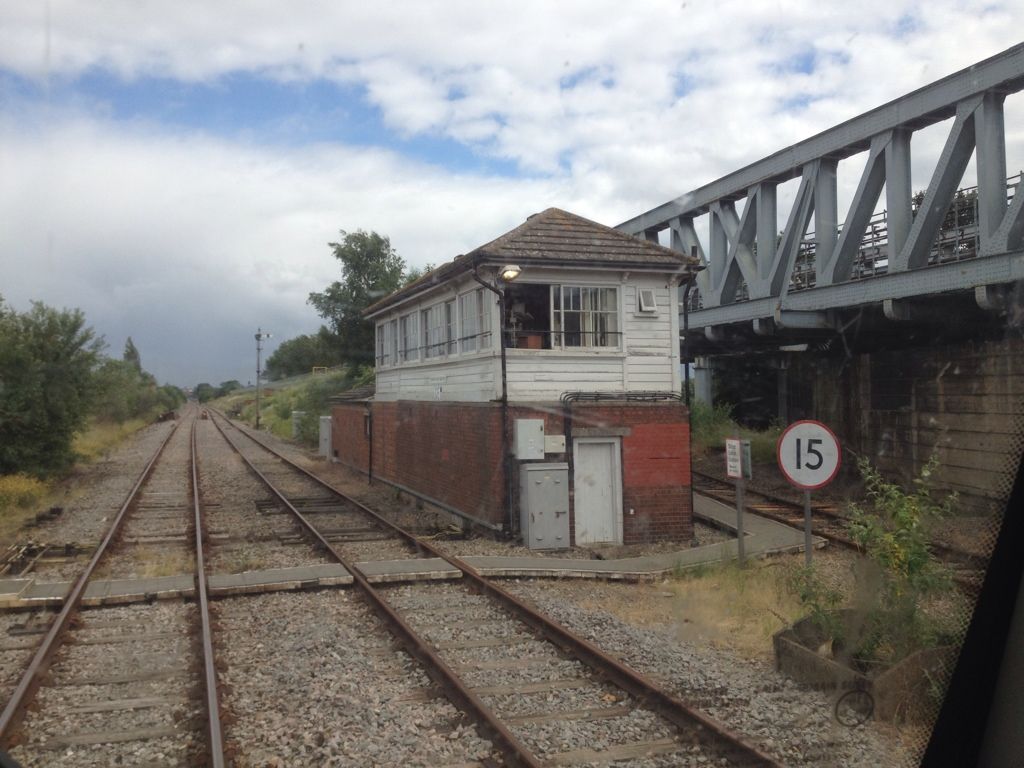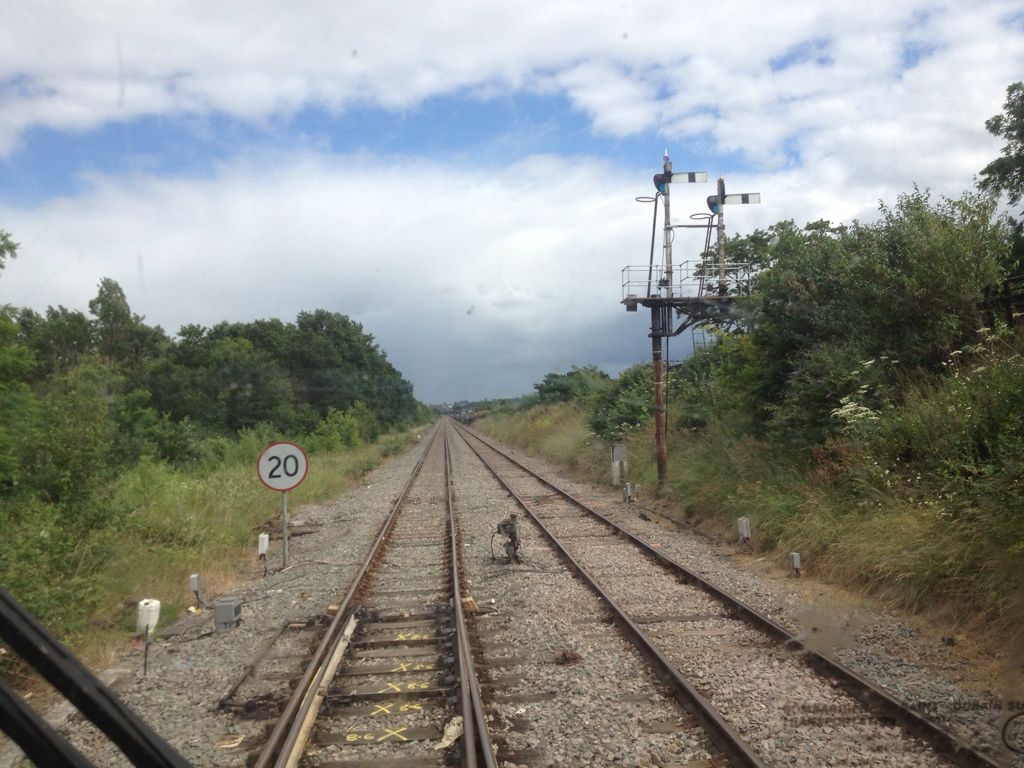-
Posts
5,972 -
Joined
-
Last visited
Content Type
Profiles
Forums
Blogs
Gallery
Events
Exhibition Layout Details
Store
Posts posted by Pacific231G
-
-
On 08/05/2024 at 23:02, 96701 said:
It looks like the 17, 18, 19 and 20 couplers are all the same arrangement, just different lengths.
https://www.kadee.com/nem_exact-train
I do know that the British NEM pockets are at different heights even from the same manufacturer.
Then they are not NEM boxes and if a manufacturer claims they are (which they tend not to but simply fit them) then they are guilty of false description. As EJStubbs says, MOROP's specification (NEM 362) for an NEM box includes its height and also the relationship bwetween the front edge of the coupling and the buffer face (though that's a dimension where manufacturers do seem to play fast and loose). If the boxes are truly to NEM362 (which in my experience many are not) you should be able to fit the same Kadee NEM362 coupler (depending on curves etc.) to all your stock.
In practice, I keep a selection of them and fit the most appropriate to each vehicle. The biggest problem I find is that on a lot of vehicles where the NEM box is on a kinematic mount (the sort with lateral movement that opens up as two vehicles go round a curve) the box tends to droop and that completely screws up the operation of Kadees (and some other couplers as well)
This is all very frustrating because Kadee produced these couplers in good faith assuming that European manufacturers would actually follow their own pan European standards as faithfully as US manufacturers do for NMRA standards (and have to if they're in the model rather than toy train market and want to stay in business)
The 17-20 Kadee couplers do indeed have the same coupler head and pivot and the length of the shank between the "fishtail" and the coupler head are of different lengths to accomodate differences in curvature etc.
Their cranked design is because in the US HO market the height of the coupler pocket and the coupler head are defined by an NMRA standard based on their standard height in the prototype. As with the prototype AAR coupler the fixed part of the coupler head is part of a casting that includes the shank so is at the same height as the drawbox (coupler pocket) and, also like the protototype, the shank can swing laterally within the drawbox . The Kadee head resembles the prototype (though it works on a slightly different principle) so this looks right .
In Europe (including the UK) it's different because no commercial automatic model coupler resembles the standard UIC draw hook so they are all designed to be mounted discretely (?) below the buffer beam which is where the NEM box was designed to sit. This is lower than the NMRA pocket for which Kadee's couplers were designed and there is no lateral movement within it so their NEM coupler is both cranked up and designed with a pivot just behind the head to enable the Kadee coupler action, which does require lateral movement, to take place. Since then, most European manufacturers have put their NEM boxes on a "kinematic" mount so there is a slightly awkward double pivot with the Kadee. The Bachmann EZimate coupler which uses the Kadee principle (now well out of patent) relies on lateral movement of the NEM box to function at all. It won't work with fixed NEM boxes.
I use Kadees on my French H0 layout and most of my older stock that didn't come with them has been retrofited with fixed NEM boxes (buying a set of tension lock couplings that come with NEM boxes is actually the cheapest way of getting them though there are boxes designed for specific European makes that can simply be glued or screwed in place)
Some of my stock is fitted with standard Kadee couplers (eg No. 5s) with their own drawboxes. Without the extra pivot, these do look neater. The advantage of fitting NEM boxes though is that I can change the couplers for the standard NEM coupler (the horrible clumsy hinged loop affair) when operating on other people's layouts.
-
 1
1
-
 2
2
-
-
On 04/05/2024 at 19:16, simon b said:
I've been trying out various ideas in anyrail again, mainly variations of Victoria park and Minories. I decided to see how compact of a 3 platform station throat I could get away with and came up with this:
That's all 3 platforms accessible for both arrivals and departures in just over 31" using medium radius points, quite a few parallel movements are possible too. Can anybody see a way to shrink it even further, or any reason that such a track layout cant be used?
That's an interesting variation Simon and does looks like the sort of pointwork you tended to see in urban terminus throats. The widening between the two main line tracks doesn't worry me and you could alway insert a bridge pier to justify it. The only difficulties I can see are the immediate reverse curve going from the main line to platform 3 and that Peco's slips are effectively 2ft radius so tighter than their medium radius points. Something coming from platform 2 to the main line is going to lurch a bit as it crosses. I experimented with a Peco sip with my own stock and just found the throwover through it a bit too much. If you could replace the Peco slip with a larger radius alternative you'd probably solve that at the expense of a couple of inches of length. For comparison, Minories with Peco medium points is about 34" long and does contain one unseparated reverse curve. This throat would look really good as a bespoke piece of pointwork.
I experimented with using a slip to shorten the throat quite a lot but found that the resulting throat seemed to be just too short. I didn't find any great virtue in trying to shorten the basic four points long, three platfom to double track, mainline throat (of which Minories is an ingenious variant) any further as a departing train seemed to leave the stage just that bit too soon. With four points lengths I did get some sense of the train departing the platform and only then leaving the scene.
-
 2
2
-
 2
2
-
-
Going back to clerestory, I just looked it up in my 1990 OED (I regard the OED as more authoritative than Chambers) and it gives both pronunciations for clerestory (and also a US spelling "clearstory"). Interestingly though it defines the word as "1. an upper row of windows in a cathedral or large church, above the level of the aisle roofs. 2 US a raised section of the roof of a railway carriage with windows or ventilators. (Middle English f CLEAR +STOREY.)
So, according to the OED, the railway usage of the word clerestory (though not its spelling) was actually an Americanism .
That though is a bit like the railway usage of turnout which was also an Americanism (from the American term for lay-by ) and doesn't appear at all in the OED in its PW usage. For that the OED only has (as the 17th defintion of the word) "point (usu plural) Brit a junction of two railway lines with a pair of linked tapering rails that can be moved laterally to allow a train to pass from one line to the other."
Interestingly though, its fourth definition of frog is "a grooved piece of iron at a place in a railway where tracks cross (19th C, orig. unkn)". So that usage is not an Americanism (as is so often claimed by those who don't like us using the word)
All this searching of the dictionary also led me to check up on "shewn". The OED describes shew as "an archaic variation of show". Does that I wonder make the GWR an archaic variation of railway? 😼
-
 1
1
-
 2
2
-
-
Thanks very much for this. The road that runs across from the West lodge is on Street view and there's no visible trace at all of the huts where there is now part of the golf course and fairly mature woods. The road still seems ot follow the same coursebut it looks as if there's been quite a lot of relandscaping, some of it no doubt to create the golf course, to the north of it.
-
On 05/05/2024 at 18:54, 009 micro modeller said:
The issue of the wheel profiles being incompatible also doesn’t seem to apply globally - e.g. as covered elsewhere on RMWeb there are some trolley/interurban museums in the US that also operate some very heavy electric railway locomotives, all DC overhead obviously but sometimes running off a lower voltage than the one they were designed for (a bit like if Crich operated an EM1, which obviously they don’t/can’t).
Reduced voltage running is entirely possible. The very extensive rural electric tramways in Haute Vienne ran at 10kV 25Hz in the countryside (which enabled long rural routes to be supplied from a single feed without the need for intermediate transformers) but at a safer 600V 25Hz on conventional tram poles within the city of Limoges. That was done with an autotransformer in each power car that converted the higher voltage to the 90-300 V required by the series wound motors . With DC you'd have to use resistors but it's still possible
A few years ago I did see (and travel on) a metre gauge SNCV diesel (originally petrol) tramcar that was running up and down the quayside track between St. Valery Ville and St Valery Port on the Baie de Somme railway in France during their 2016 Fête Vapeur. This metre gauge railway uses the same crossing and checkrail clearances as the standard gauge (some of it is three rail mixed gauge) but SNCV in Belgium clearly used much tighter tramway clearances so the tramcar had to prodeed very gingerly over the one turnout it had to negotiate on its route and there was a lot of wheel drop through the crossing.

These are not of course abandoned rails in the road - quite the opposite nowadays!
For street running shared with other vehicles (most typically on docks and quaysides), railway crossing clearances require a larger gap between rail and check rail than that used by most urban tramway systems. This can be quite hazardous for other road users - especially cyclists. and was ISTR one of the reasons why the Weymouth Harbour Tramway was lifted (shame!) However, a lot of modern urban tramways, though they run on the streets to some extent, don't actually share the same parts of the street very much with other vehicles and tend to run largely on their own reservations or on streets closed to other vehicular traffic, apart possibly from buses that tend to have wide tyres anyway.
-
 4
4
-
 1
1
-
 1
1
-
-
23 hours ago, 1E BoY said:
Wartime HQ of the London, Midland & Scottish Railway following evacuation of Euston House. Plenty of wartime buildings on site some in wood and others brick plus underground bunkers etc.
The site was purchased just before the outbreak of war by Lineside Estates.
Many of the wartime buildings (some derelict) were on site. The Civil Engineering Training Centre was at one end of the site away from the mansion. As mentioned it had its own track etc. which was lifted and replaced several times each year!
I worked at the Management Training Centre from 1981 - 83 looking after the audio visual requirements. In addition to training courses, the MTC hosted conferences and meetings, It was always busy.
BR published "The Grove Story" in the mid 1980s which gives plenty of information on its wartime role. The Imperial War Museum also has film footage of The Grove showing its construction and the relocation of departments out of London.
It was all achieved in a very short timescale and activated during the weekend war was declared!
You might want to take a look at in now on Google Earth 3D. I could seed no sign of any of those wartime buildings but you might be able to locate where they were and what's there now. New hotel buildings I imagine.
(Why on earth am I so interested in a hundred yards or so of track, one point and a signal box with no rolling stock?🤔 )
-
 2
2
-
-
23 hours ago, keefer said:
It would seem that the 'Research Centre' is actually BR's famous facility 'The Grove'.
IMDb mentions 'British Rail Centre, Watford' and a general search brings up a thread on railforums.co.uk:
John Webb states (after comments that the track etc. don't look quite right):
"I can confirm that the bit of railway seen in the "Positive/Negative Man' was a training set-up at The Grove near Watford; one of our members had been there. Even Civil Engineers have to be taught about railway equipment in general when they are working on the railway so they know what is what alongside or crossing the track or whatever they are expected to work on. The signal box was part of the installation by BR, I understand."
Thanks for this Keefer. I knew that The Grove had been one of the locations but, as a BR management training centre, the buildings looked incongruous with the country house setting. It's pssible of course that what appear to be adjoining buildings in a film are actially totally different locations though that's less common than in a feature fiilm for that type of TV film where they tended to "dress" locations rather than build complete sets. The lab buildings and those around the "railway" generally looked very 1940s "Ministry/MoD" style. Was the Grove used during the war for some purpose that would have added a number of that kind of building somewhere in the grounds? (They're more solid than the "huts" at Bletchley Park but look like the sort of buildings you tended to find around military bases or old RAF aerodromes)
Exploring the site on Google Earth 3D, there's no trace of anything that would look like those buildings as they appeared in the episode but they were undoubtedly demolished when it was turned into a luxury hotel.
.
-
 1
1
-
-
I've just been watching an episode of the Avengers called the positive negative man where much of the action takes place in an abandoned top secret government research centre. It looks like an old military facility but what intrigued me was that outside the typically Ministry single story brick building was a standard gauge railway track leading away from it with a set of points, a short post semaphore signal and, in the disance a small signal box. I suspect that it may be a then disused part of the MoD's Bicester site but I didn't recognise it. No trains but the villain's henchman who is charged up to about 10 000v of static - but protected by a layer of grease (well it is the Avengers) uses the rail to shock Steed, who is touching it, from about thirty yards away.
-
 3
3
-
-
23 hours ago, Gordonwis said:
estd date is 1927 IMHO
The French Wiki entry gives both dates but the earlier one must have been a typo. The company's own website says that it's been an international company since 1927 and its founded Auguste Perron was succeeded by Loïc Perron (I assume his son) in 1964 followed by Emmanuèle Perron in 1996 so very much a dynastic business. It chose to stop operating during the occupation but resumed in 1945 when there was massive rebuilding of the war devastated SNCF network . When NGE took over TSO in 2011 Emmanuèle Perron became its vice-president and she is still on the NGE board.
I have no idea why the Sud-Ouest name was chosen.
-
7 hours ago, Rugd1022 said:
Some French railway footage in this clip from a 1967 Yves Montand film called 'Vivre Pour Vivre'...
It's a French film and the railway footage is appropriately emotional but I had a closer look and found the complete fim. The train is actually arriving in Amsterdam. The carriage number NS 752 was a bit of a giveaway, but looking more carefully, the arriving train is in blue and white livery. However, there is a continuity error as when Yves Montand, who is really already in Amsterdam with his lover (Candice Bergen), sneaks aboard the just arrived train from the wrong side to pretend to get off (having stuffed his bag with French magazines bought at the station news stand) to greet his wife (Annie Girardot) the carriage is now green, (probably shot on a different platform where it was parked for the film). There is a later scene aboard the Amsterdam-Brussels-Paris sleeper but you only get to see fairly tight close ups of the characters in their compartment and the corridor.
If you like trams there are a fair number of them from that era at the tram station in front of Amsterdam CS.
Thanks for finding it though as it's a good film that I didn't know. It was Claude Lelouch's first film after Un Homme et une Femme and he seemed very fond of jump cuts (and a few line crosses).
-
 4
4
-
-
11 hours ago, Whitcan said:
A quick question please. I am increasing the number of Infrastructure movements on my layout, based in the Drome Department. Researching track machine liveries, I was taken with the TSO branded ones but, given that TSO is Travaux du Sud-Ouest, what is their sphere of operations? Is it nationwide, as I have seen references to works in Paris? Would they operate in the Lyons area?
Thanks in advance for your help.
Paul
TSO is a private company set up in 1852 and a supplier to SNCF and to other railways. Its name dosesn't define it geographically (if it ever did) but may be where it started but its registered offices are actually in Chelles Seine et Marne. It also for example laid the track for the Channel Tunnel and for Crossrail (Elizabeth Line). There is a Wikipedia entry for it, just search for Travaux du Sud-Ouest. There are references to considerable works in Paris.
-
 1
1
-
-
20 hours ago, Enterprisingwestern said:
A Statler and Waldorf moment!
Mike.
You Muppet Mike. I'm not that old 🤣
-
 1
1
-
-
On 22/04/2024 at 08:36, Hobby said:
It does work, I watched it on iPlayer yesterday, though I wasn't as impressed with it as you two, perhaps your hype had over-hyped it!
No, not overhyped at all. Mine was a well balanced and informative review 😁😁
It was the Lorenbahn that really fascinated me as unusual NG railways like that always have. The once ghost U-Bahn station in what was East Berlin also interested me as my only visit to Berlin (both West and East) was in 1967 when the cold war was especially frigid and the city looked just like it did in Funeral in Berlin. The oddity was that the railways in West Berlin (including the S Bahn but not the U Bahn) were operated by DR not DB though I assume, perhaps wrongly, that the train crews and operating staff stayed on their own side of the wall.
-
 2
2
-
-
8 hours ago, keefer said:
Thansk foir this Keef
Though it's listed, it doesn't appear to be available for viewing yet- there is no hyperlink though there is for the other editions listed-. I think though that the final Tx was today so it should be avaialable very soon. It's well worth seeing
-
 1
1
-
 1
1
-
-
On 31/03/2024 at 11:03, Oldddudders said:
I have a phobia about terminal stations without a run-round. I see operations beyond multiple-units or pull-push being awkward at best. Clearly I have missed something.
What you have missed, but Ian Futers didn't because he modelled it, is the old three platform terminus at Fort William with just two points. Although it originally had a releasing crossover between the two "bay" platforms, that largely fell out of use once the Mallaig extension turned the terminus into a reversing junction and it was taken out in the 1950s.
The terminus was actually too intensively worked for a run-round to be of much use as, several times a day, trains from Mallaig and Glasgow crossed there often followed by a summer relief train. To add to the fun, sleepers and dining cars from Glasgow generally terminated at Fort Williiam with the rest of the train going forward to Mallaig but sometimes with an observation car attached (and vice-versa in the opposite direction). There was at one time even a summer only embryonic motorail type service that ferried accompanied cars between Fort William and Mallaig to avoid the "single lane with passing places" A road between them. Tail loads of fish vans were also not infrequent and there was often work for not one but two station pilots. I've watched the operation there during a couple of family holidays in the 1960s and it was fascinating. Nothing much happened for several hours then all hell broke loose when trains arrived one after the other from both glasgow and Mallaig.
It is an interesting irony that small branch line termini almost invariably required a run-round loop when trains were loco hauled but busy main line and suburban termini very often did not-an irony not lost of Cyril Freezer when he designed Minories!
One of the most interesting layouts that I've operated was Giles Barnabe's On16.5 Puerto Paseo which, in about five feet, included a three platform terminus at the end of a single track main line with a two road goods yard and a kickback to the local docks .


These two images show the whole scenic part of the layout. The turntable was solely to turn the railway's single ended railcars.
Puerto Paseo didn't have a releasing crossover but, with a well thought out operating sequence that took about an hour to work through, I found that I could enjoy operating several sequences (taking it in turns) during an exhibiton day without losing interest.
Here are three more images, just because I really like this small layout and its operational potential.


-
 10
10
-
 2
2
-
-
BBC News Channel is currently showing a fascinating edition of The Travel Show - "Germans and their Railways-a Love Story". It's based on their young reporter exploring Germany with a "Deutschland Ticket" - which gives access to the country's regional rail network for I think 47€ a month (You have to subscribe to get the ticlet and, if visiting as a tourist, remember to cancel before you pay for the next month) .
It includes the Alexanderplatz station on the Berlin U-Bahn, which was a ghost station during the Berlin Wall period as it was in East Berlin on a West Berlin line that passed through a bit of East Berlin. Also, the Wuppertal Schwebenbahn and its new museum that's just opened and, most interesting of all for me, the Lorenbahn that serves islands on the north coast that regualrly flood and on which locals run their own homebuilt railcars (the railway is actually owned by the government agency that protects the coast from erosion) Unfortunately visitors aren't supposed to ride on them unless staying with someone on the islands (in this case the owner of a B&B)
The programme is inevitably a bit superficial but nevertheless very interesting and well shot.
It's on the BBC News channel I think once more today and once tomorrow before the next edition appears.
-
 1
1
-
 1
1
-
 2
2
-
 1
1
-
-
Which series of The Sweeny had the shot in the opening titles of the pedestrian overpass (long since dismantled) over Shepherds Bush?
-
11 hours ago, adb968008 said:
Doesnt this same logic apply to CDL ?
i’m not arguing against cdl, i’m arguing for seatbelts on trains, as at least an optional… as a family man i’d have my kids wearing an airline style lap belt on a higher speed service, just as they do on a plane, car, anywhere else.
There's no sensible comparison between an aircraft or road vehicle and a train. The chances of a collision or derailment while on a train are minute compared with a road vehicle which is also likely to swerve or brake heavily to avoid an accident. While an air accident is probably equally unikely, at least on a scheduled flight, the chances of heavy turbulence, a violent manouevre , a heavy landing or an aborted take-off are fairly common- that's why one is required to wear one's seatbelt during take off and landing and advised to while seated throughout the flight.
Seat belts in cars had a massive effect on fatalities and "life changing" injuries. On trains, any benefit would be very close to zero but the cost would not be.
-
 1
1
-
 9
9
-
-
On 06/04/2024 at 13:24, 2E Sub Shed said:
Old enough to remember those Government Information Films on TV urging us to unplug everything at night before retiring to bed.
Anyone remember the acronym SIDE?* I know what it means (electrical engineering was part of my OND though we knew it as Magic) but I don't know why I can still recall it. I think it was in one of those OU programmes, something about HV electrical work, that I sometimes ended up putting out on BBC-2. but that was over forty-five years ago. Clearly it was a very good acronym.
* Switch off. Isolate, Dump, Earth.
-
 3
3
-
-
On 21/03/2024 at 22:06, PhilJ W said:
Energex is the is the electricity distributor for South East Queensland. I wouldn't want to argue with this particular arachnid about whose meter it is either.
"Some funnel-web species deliver a bite so toxic that it can kill an adult human within 15 minutes." I'm always rather amazed that there are any Australians still alive.
-
 2
2
-
 1
1
-
-
-
On 06/04/2024 at 18:00, The Johnster said:
Common operating mistake at exhibitions, BLT layouts; train arrives and stops short for the loco to be uncoupled and draw forward for running around. No, unless the buildings are placed to facilitate it, you are making your passenger walk to the exit gate in the rain and having to unload parcels out in the open as well. Stop close to the buffers, wait for the passengers to clear the premises and the parcels/mail work to be done, then set back before uncoupling the loco. Run around, couple on the other end, and wait a minute while the guard performs the brake continuity test (I will probably walk away from your layout if you simply continue to push the stock back towards the buffers or stay in that postion), then set back to the buffers. Passenger can now board conveniently and loading parcels/mails be done in proximity to the office and messroom.
I agree about carrying out all the relevant operations properly but I do compress the time required for things like coupling & uncoupling, passengers boarding and alighting, and brake tests. At an exhibution, If nothing at all happens for a whole minute while the imaginary brake test is suposedly carried out or for two minutes to give the imaginary passengers time to open the imaginary doors, then everyone else watching will probably walk away.
-
 1
1
-
 1
1
-
-
On 28/11/2023 at 17:06, big jim said:
Not long after I started with chiltern we did a DVT move to Doncaster, the unique white and blue one, and we went Wembley LMD-Neasden Jn-Acton canal wharf (reverse)-Wembley yard (reverse)-Primrose Hill-north london line to incline down to the ECML then onward to Doncaster, Mr Roast was the instructor/conductor of course, can’t remember why I was on it though, possibly DVT trainingThese might be of interest to you, taken 1st July 2012 on a chiltern diversion into Paddington, I got a conductor at West Ruislip and I sat in the 2nd mans seat to Paddington and back
and a couple from Christmas Day 2021
I've only just seen these Big Jim but thanks for posting them. The only time I mamaged to travel on that stretch of line was during that same Chiltern Railways diversion in 2012. I got the Central Line from Perivale to W. Ruislip then the Chiltern to Paddington. Since they cut the line approaching OOC, the Greenford Branch has been a lot less interesting though we had some excitement before Easter when the late Adrian Shooters' new battery electrics sets were being tested. How soon they come into service is anyone's guess buit the branch is being used as the test location for these trains that GWR intend to use on most of their shorter branch lines . They are in any case a bit out of era for this layout unless WCML applies rule 1.
-
I do use cleaning blocks but those sold by DOGA which seem far less abrasive than the Peco track rubbers. I use IPA sparinngly to clean between switch and stock rails.
Something that Pendon uses that may be helpful is the rough side of a small piece of hardboard. For the Dartmoor and Vale scenes this is mounted on a skeleton bogie wagon using a weighted holder to keep presure on the rail but I've used my own, cut from a piece of hardboard, as a hand tool on my own layout to give the track a final polish.




.png.19b9ca72c292288b9e6637a9753083a8.png)























Hornby announce TT:120
in Hornby
Posted
I'd be very surprised if Peco and Hornby didn't know that both were going to launch into the British market with TT. Peco was of course already well into the scale with track and I suspect that they'll be selling as much if not more of that into the rest of Europe than into Britain.
I also rather dislike the TT120 term but accept the need for it. Thanks to Tri-ang Toys, for a whole generation of British modellers, TT meant 3mm/ft scale and they were largely unaware that there was any other flavour of TT.
It was Peco via Railway Modeller that coined the term TT-3 and, for several months after the launch in 1957, it was only they or those selling their track that used it. Curious, as the track was the one thing that was common to TT-3 and "proper" TT, which Peco was already supplying track for. (Rokal and to some extent HP and Kemtron etc. had been imported for several years before Tri-ang's launch and George Reffin was exhibiting a rather nice American TT layout)
I did see in R-M around that time occasional use of the awkward (and technically incorrect) TT25 to differentiate normal TT based on it being close to 2.5mm/ft (actually 2.54mm/ft ) even though it was clearly defined as 1:120 or 1/10 inch to the foot which, if you do the sums, happens to give a very accurate track gauge of 1440mm with 12mm